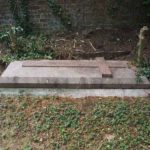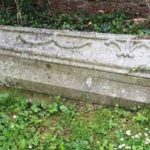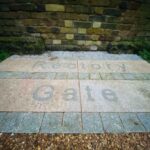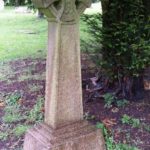St Peter’s Rectory
Rectory Lane takes its name from the Rectory of St Peter’s Church. This is the house provided by the church for the Rector — the priest-in-charge — of the Parish of Great Berkhamsted. In fact, there have been three different Rectories on this lane.
The Cowper Rectory
The original rectory stood to the west of the Cemetery. It is not known exactly how old this building was. This was the birthplace of the poet and hymn-writer William Cowper, who was born in 1731, the son of the Rev. John Cowper, Rector of St Peter’s 1722-1756. William Cowper’s many works included the Olney Hymns and he wrote the hymn “Oh! for a closer walk with God”. His poetry gave the English language the phrase: “God moves in a mysterious way”. In the 1780s, Cowper was active in the anti-slavery movement and associated with abolitionists such as John Newton and William Wilberforce. In the 20th century, Cowper was often quoted in speeches by Dr Martin Luther King. Cowper died in 1800 and was buried in St Nicholas’s Church in East Dereham, Norfolk. He is commemorated in St Peter’s Church by two windows which also depict his pet hares.
The Crofts Rectory
From 1810-1851, Rev John Crofts was the Rector of St Peter’s, and during his incumbency he drove many improvements. In 1820 he oversaw Jeffry Wyattville’s restoration of St Peter’s Church, and around 1835 he built a new Rectory further up the lane, and demolished the old Rectory. This large Victorian red-brick house served as the St Peter’s Rectory for over a century. Some of the outbuildings of the original Rectory survived, including the coach house (still in use today as the Rectory garage) and the old well-house known as Cowper’s Well.
It is thought that the large octagonal brick gate piers which now stand at the entrance to the Cemetery originally stood across Rectory Lane, providing an imposing gateway to a driveway leading up to the Crofts Rectory. Possibly in the 1870s these gate piers were dismantled and turned around 90º to replace the wooden gates at the Cemetery entrance.
Rectors buried in the Cemetery
Another noted Rector who lived here was Rev James Hutchinson (1805–1873). He oversaw a second restoration of St Peter’s Church, this time employing the services of the renowned architect William Butterfield. Hutchinson did not live to see the renovations completed, as he died in 1873 and was buried in Rectory Lane Cemetery.
The Rectory became home to another writer when John Wolstenholme Cobb was appointed Rector in 1871. Cobb is renowned in Berkhamsted as a local historian who published his extensive research in 1855 in The History and Antiquities of Berkhamsted. He remained Rector of the parish until his death in 1883, and was buried in Rectory Lane Cemetery.
In 1894, Rector Rev Arthur Johnson donated an acre of the Rectory garden to allow the Cemetery to be extended. This is the land south of the Memorial Arch, running up the hill as far as the upper entrance gate.
The lost Rectory Gate
When Rectory Lane Cemetery opened in 1842, it incorporated a lane running parallel with the High Street which may have existed before the Cemetery. This route, marked on Victorian maps as Green Lane, cut through from Chesham Road, via the St Peter’s Rectory to Three Close Lane. There was a gate leading from the Rectory into the Cemetery. At the other end, a gate met the main entrance to Highfield House, a grand 18th-century villa that stood on the hill on what is now Victoria Road and Highfield Road.
The lane was retained as a walkway through the Cemetery along its southern edge and was tastefully planted out with a row of 12 Irish Yew trees on either side, possibly symbolic of the 12 Apostles in the New Testament. When the Cemetery was extended in 1894, the boundary moved further up the hill, and this path was now running through the middle of the Cemetery.
At some point this thoroughfare was closed off when the gates at either end were walled off. The different colour of brickwork in the wall on the western side is the only evidence of the former gate through to Rectory Lane. A right of way for the Rector of St Peter’s does still exist from the Rectory through to Chesham Road. During the renovation works 2017-20, the original Victorian paths were relaid, and the locations of the former Rectory Gate and Highfield House Gate have been recalled by inlaid stone markers.
The 1960s Rectory
In the 1960s, the Crofts Rectory was sold and a new, less grandiose house was built close to the site of the original Rectory. The Victorian Rectory — now known as “The Old Rectory” — is still standing today at the end of Rectory Lane, and is in use as a private house.
Cemetery connections
Discover the memorials in Rectory Lane Cemetery with historical links to St Peter’s Rectory
5 burials are found — click on a burial below to find out more:




 Cobb plot
Cobb plot Hutchinson plot
Hutchinson plot Former Rectory Gate
Former Rectory Gate Johnson plot
Johnson plot Gravestock plot
Gravestock plot













 Personalities of the Past
Personalities of the Past
 Remarkable Women
Remarkable Women

 Military graves
Military graves